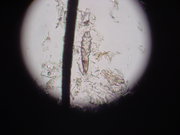 Demodex canis
Demodex canis
|
From Wikipedia the free encyclopedia, by MultiMedia |
Mange is an irritation of the skin, primarily resulting in hair loss and sometimes including itching and inflammation, all of which are caused by microscopic mites. Mange is most commonly found in Dogs and other canines, but it can occur in other domestic and wild animals, and occasionally in humans.
The mites embed themselves in the hair follicles or skin, depending on the type, making both detection and treatment difficult. The condition can be treated with parasiticidal shampoo, topical or oral medication, or injections, but it takes time and patience for repeated applications, and almost always requires veterinary care.
Two types of mites produce canine mange, and each has similar but somewhat different symptoms.
 Demodex canis
Demodex canis
Also called demodicosis, demodectic mange is caused by an overpopulation of Demodex canis, a mite that occurs naturally in the hair follicles of most Dogs. In most Dogs, these mites never cause problems. However, in certain situations, such as an impaired immune system, intense stress, or malnutrition, the mites can reproduce too rapidly, causing anything from mild irritation and hair loss on a tiny patch of skin to severe inflammation, infection, and--in rare cases--a life-threatening condition. Small patches of demodicosis often correct themselves over time, although treatment is usually recommended.
Minor cases of demodectic mange usually do not cause much itching but might cause pustules on the Dog's skin, redness, scaling, hair loss, or any combination of these. It most commonly appears first on the face, around the eyes, or at the corners of the mouth, and on the forelimbs.
In the more severe form, which usually develops in Dogs who have previously suffered minor cases, hair loss can occur in patches all over the body and might be accompanied by crusting, pain, enlarged lymph nodes, and skin infections.
This variety of mange is not generally contagious; these mites thrive only on very specific hosts (Dogs) and transmission usually occurs only from the mother to nursing puppies during the first few days after birth.
Some breeds appear to have an increased risk of mild cases as young Dogs, including the Afghan Hound, American Staffordshire Terrier, Boston Terrier, Boxer, Chihuahua, Shar Pei, Collies, Dalmatian, Doberman Pinscher, English BullDog, German Shepherd Dog, Great Dane, Old English SheepDog, American Pit Bull Terrier, and Pug. There is strong evidence that a predeliction for juvenile demodectic mange is inherited.
Also known as canine scabies, sarcoptic mange is a highly contagious infestation of Sarcoptes scabei canis, a burrowing mite. The canine sarcoptic mite can also infest humans and cats, although usually not severely, as its natural host is Dogs.
These mites dig into and through the skin, causing intense itching and crusting that can quickly become infected. Hair loss and crusting frequently appears first on elbows and ears. Skin damage can occur from the Dog's intense scratching and biting.
Affected Dogs need to be isolated from other Dogs and their bedding, and places they have occupied must be thoroughly cleaned. Shaving is sometimes warranted.
For more information, see Scabies.
Veterinarians usually attempt diagnosis with a skin scraping, which is then examined under a microscope for mites. Because they are burrowing creatures, mites are not always present on or near the surface of the skin when the scraping takes place. As a result, diagnosis is often based on symptoms rather than actual confirmation of the presence of mites. This also means that mange is occasionally misdiagnosed as other medical conditions, and vice versa.
Dogs, made by MultiMedia | Free content and software
This guide is licensed under the GNU Free Documentation License. It uses material from the Wikipedia.